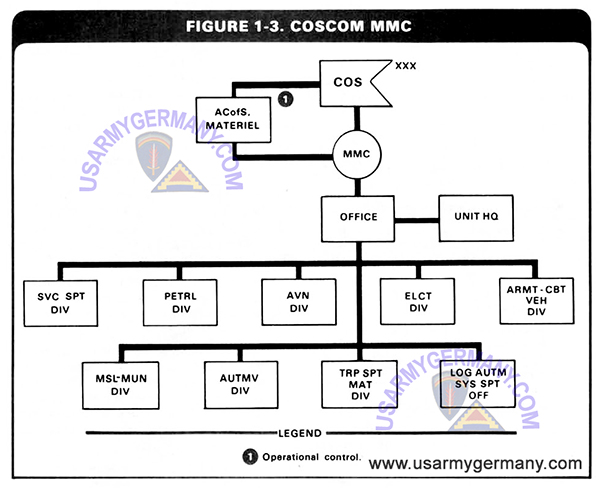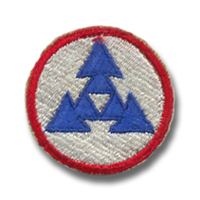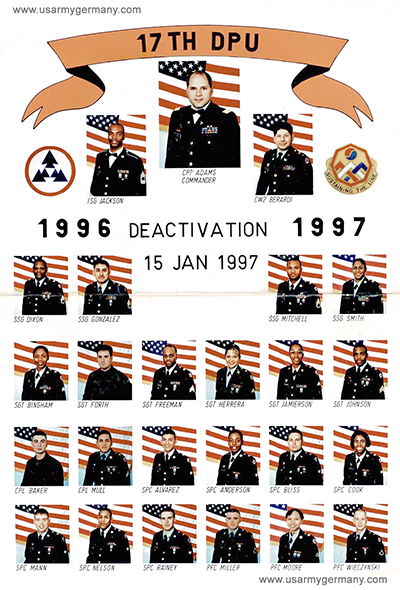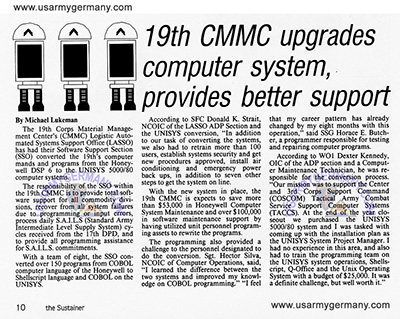| If you do NOT see the Table of Contents frame to the left of this page, then Click here to open 'USArmyGermany' frameset |
|||
|
Special
Troops Battalion, 3rd Support Command |
|||
|
|
|||
|
|||
|
|
|||
| STB History | |||
| 1989 | |||
| (Source: THE SUSTAINER, Jan 1989) | |||
| Sharing in the unique mission of providing logistical and life support services to the 3rd Corps Support Command and other V Corps units, soldiers from Special Troops Battalion (STB} were busy throughout 1988 with a variety of missions ranging from data processing to chemical decontamination. According to Lt. Col. Jules Hampton, commander, the battalion has "the most critical resource of the Army, people." Adding that they were doing a super job, he said, "Our soldiers are ready and prepared for anything and our equipment readiness is just as great. I'm proud of our soldiers. They did an excellent job setting up at Wildflecken during REFORGER '88. Everything was so elaborate and well done." STB has six key components: Headquarters and Headquarters Company (HHC) -- provides daily administrative, training and supply maintenance assistance; 17th Data Processing Detachment (DPD) -- responsible for all ADP (automatic data processing) requirements for V Corps; 19th Corps Materiel Management Center; 502nd Movement Control Center; 13th Chemical and 95th Chem Company -- both provide chemical decontamination and NBC special services to V Corps units. With 900-plus soldiers in the battalion, Hampton says that his soldiers are "Sustaining the Line." LTC Jules Hampton, Bn commander CSM Robert Dare, Comd Sgt Maj |
|||
|
|
|||
| 17th Data Processing Unit | |||
| 1970 | |||
| (Source: STARS & STRIPES, April 4, 1970) | |||
| The Data Processing Company of V COSCOM demonstarted for the first time in USAREUR the operation of an IBM 360/40 in the field. Among those present to witness the demonstration were Gen James H. Polk (CINCUSAREUR); Maj Gen H. N. Maples, DCofS Logistics, USAREUR; Lt Gen C. E. Hutchin, Jr. (CG V Corps); and Maj Gen Ralph L. Foster (V COSCOM Cmdr) The Data Processing Co received its IBM 360/40 in March 1970. The computer, housed in four vans, was set up at Gibbs Kaserne. The company's computer had to go through extensive user testing before being accepted by the government. The permanent location for the computer will be at the IG Farben Building where COSCOM headquarters is located. |
|||
| 1971 | |||
| (Source: STARS & STRIPES, Aug 18, 1971) | |||
| The Data Processing Company, V COSCOM was activated in April 1969. The company's primary mission is to provide computer and electric accounting machine support to V Corps, administrative and logistical support to elements of V COSCOM Materiel Management Activity (MMA), and pertinent management information to other V COSCOM MMA elements. To perform its mission, the company is equipped with IBM 360-40 computers. These computers are specifically designed for use in the field. (Normally operating in an office environment,) they can be loaded into special air-conditioned vans equipped with air-suspension shock absorbers and transported to the field during exercises or in an emergency situation. The Data Processing Company has a counter-part also equipped with 360-40s in VII COSCOM. Both companies maintain close coordination with the Management Information Systems Support Agency in Karlsruhe. |
|||
| 1996 | |||
| 19th Corps Materiel Management Center | |||
 Organization of an MMC per FM 54-23, 1984 |
|||
| 1984 | |||
| (Source: Excerpts from FM 54-23 Materiel Management Center, Corps Support Command, 28 December 1984) | |||
| COSCOM MMC Role The COSCOM Materiel Management Center (MMC) is the heart of the corps-level supply and maintenance management system. It performs integrated GSs upply and maintenance management for all classes of supply (except maps, medical, and COMSEC) for which the COSCOM has jurisdiction and responsibility. The MMC acts on the requirements of supported forces. The MMC consists of materiel management divisions which are aligned with those of the TAACOM MMC, the TAMMC, and the AMC NICPs. The center functions under the operational control of the ACofS, Materiel, COSCOM, and is commanded by the center commander who also serves as the COSCOM deputy ACofS, Materiel. Each division exercises total day-to-day integrated materiel management of assigned commodities. ORGANIZATION The MMC (see figure above) is organized with an MMC office, a unit headquarters, a service support division, a logistics automations ystems support office, and seven materiel management divisions. Six of these divisions (aviation, electronics, armament-combat vehicle, missile-munitions, automotive, and troop support materiel) are organized along functional lines with an attempt to align them as closely as possible with the CONUS-based Army Materiel Command (AMC). The troop support materiel division also manages the subsistence, general and common materiel of the Defense Logistics Agency (DLA) and the General Services Administration (GSA). The seventh materiel management division of the MMC is the petroleum division. ADP support is provided by the logistics automation systems support office. The service support division provides those services of a technical nature, less administration, common to all materiel management divisions. Each division chief is responsible for integrated materiel management of assigned commodities as determined by alignment with CONUS sources of support. A functional branch breakdown within divisions permits special management of major item supply, maintenance, and repair parts supply. Each peculiar repair parts supply branch of a division has a common repair parts supply expediter who insures close coordination with the common repair parts supply branch of the troop support materiel division. Individuals from the functional branches can be designated as a management team to combine supply, maintenance, and repair parts expertise for intensive management of a designated critical item. MISSION To accomplish its mission, the COSCOM MMC - COSCOM MMC AND ADPC An ADPC is assigned to the COSCOM headquarters to support all appropriate CSS functions. It is supervised by the AMO who is assigned as a special staff officer on the COSCOM staff. The AMO operates under the staff supervision of the COSCOM chief of staff. Personnel assigned for ADP support operate the ADPC and provide service to the various elements of the COSCOM MMC and MCC. The COSCOM MMC and MCC provide guidance to the commander of the ADPC on the type and frequency of reports required and instructions and parameters for routinef unctions and operations. The ADPC canr espond to queries and requests that fall within parameters and instructions provided without involving the MMC in each action. Basic computer programs used by the ADPC are centrally developed and maintained using STAMMIS. The COSCOM MMC operates within the confines of standard Army systems established for supply, maintenance, financial, and personnel operations. The programs accept requisitions prepared in accordance with MILSTRIP. Other computer programs support the SAMS, the SIDPERS, and other designated functional systems when adopted. While ADP operations in the COSCOM MMC are somewhat routine, they are vital to the accomplishment of the MMC's mission. |
|||
| 1989 | |||
| (Source: THE SUSTAINER, January 1989) | |||
| (During 1988 the 19th Support Center put on line the Corps Asset Visibility Program (CAV-P). The computer program, which is currently saving V Corps thousands of dollars, was designed by Sgt. Donald Freeman, a materiel control and accounting specialist who was assigned to the 19th Corps Materiel Management Center (CMCC). "The program will help us maintain our high state of readiness," said Col. Walter Bawell, commander of the 19th CMMC, and we expect it to save $400,000 Corps wide. In addition to the CAV-P, the 19th Support Center also implemented Class I (food) automation during REFORGER '88. Providing integrated supply and maintenance management for many of the supplies used by V Corps, including logistic support, the 19th Support Center acts as a liaison to the Corps and its supported units. |
|||
| 1990 | |||
| (Source: THE SUSTAINER, July 1990) | |||
| The article provides some information on the Software Support Section of the 19th CMMC and its role in converting the center's software programs in preparation for the implementation of a new computer system at the 17th Data Processing Detachment. | |||
| 502nd Transportation Company (MCC) | |||
| 1985 | |||
| (Source: SUPCOM Log, November 1985) | |||
| The 502nd Transportation Company became the 502nd Corps Movement Control Center, Oct. 1, and assumed a much expanded mission as the result of a theater-wide reorganization of movement control assets. The Transportation Operational Organization Plan is being implemented to structure the CMCC's operation to resemble their wartime mission according to the commander, Lt. Col. Richard D. Hill. "In other words," he said, "we will do in peacetime what we would do in war." Lt. Col. Hill said their mission includes supervising movement control and highway regulation teams, controlling personnel and materiel movement throughout the corps area, regulating highway movements and acting as a liaison with other U.S. forces as well as allied and host nation transportation agencies. Under the theater-wide reorganization, Lt. Col. Hill said, "The mission has expanded from just a corps tactical mission to a corp-wide transportation mission. This will also include non-corps units within the corps area." He said the 502nd also assumed management of non-tactical freight movements from local installation transportation offices. "Under TROOP," he said, "the freight sections were removed from the ITOs and put under the Branch Movement Control Teams which are a part of our new structure." He added that in all, nine BMCTs will be located in communities throughout V Corps. Lt. Col. Hill said that in addition to tactical transportation, CMCC will be supervise the movement of containerized freight in the corps area for DoDDS, DEH, AAFES, AFN and other organizations. The unit's increased role in directing movement of soldiers, equipment and materiel, brought with it additional personnel and facilities. Lt. Col. Hill said his organization now includes the Movement Control Team and Rail Movement Management Team, in Frankfurt, and the Highway Movement Control Team, in Wiesbaden. Those teams were formerly assets of the 3rd Movements Region which was deactivated, Oct. 4. With the addition of the BMCTs, Lt. Col. Hill said, the divisions will now coordinate through them for transportation needs rather than going through a variety of different agencies. He said the end result of the new arrangement will be a greater ability for the CMCC to monitor and trouble shoot corps transportation requirements. In the area of tactical movements requiring march credits, Lt. Col. Hill emphasized that divisions will go directly to the Highway Traffic Headquarters, in the CMCC. "In the past," he said, "the divisions went directly to the HMCT in Wiesbaden for march credits and we didn't know what they were doing until they got into trouble. Now, they go directly to the HTH where they come into our tracking system." He said the German government still processes march credits under the same agreements previously used but he said, "We now have the capability to monitor the processing of those requests." When TROOP is fully implemented, the CMCC will have a strength of 15 officers, 127 enlisted soldiers and 44 civilians, to staff the CMCC and BMCTs. Lt. Col. Hill said the increased staff should all be on board and the, new system fully operational by Feb. 16, 1986. Click here to read an article on the deactivation of 3rd Movement Region Click here to read more about the theater-wide reorganization under the TROOP Plan |
|||
| Related Links: |
|||


